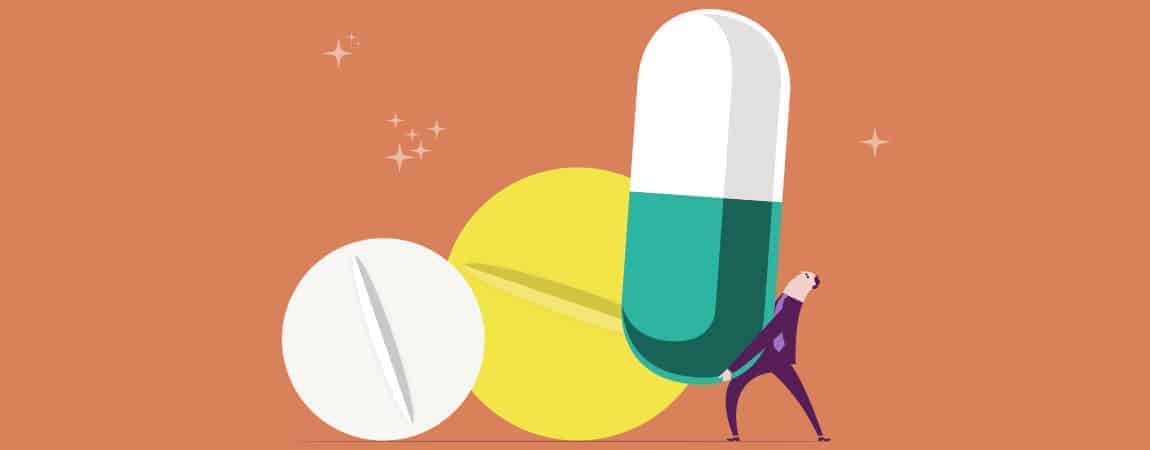Experts Discuss: The Rapid Rise of Weight-Loss Drugs
We recently hosted our first-ever expert panel to go in-depth on the meteoric rise in popularity of GLP-1 agonist medications being used as...
Connected Navigation Platform
Guiding to high-value care
Behavioral Health
Foster a mentally healthy workplace
EAP
Supporting holistic wellbeing
Virtual MSK Care
Reimagining musculoskeletal care
Virtual Primary Care
Powered by smart navigation
Surgery Centers of Excellence
Best-in-class surgical outcomes
Virtual Urgent Care
Immediate care, any hour of the day
Chronic Care
A new approach to chronic care
Integrations
Flexible to any strategy

Drug costs are out of control, and one culprit has recently been placed in the hot seat: prescription drugs. Yearly price hikes for prescription drugs are now an accepted norm: In 2014, drug spending rose by 13%, the most significant increase in over a decade. In the past three decades, drug prices increased by nearly 2X, far exceeding the rate of inflation. All the while, drug companies have been enjoying higher profit margins— merely because they can.
Without regulations or consumer knowledge of prices, the sky’s the limit for the manufacturers who produce the drugs we depend on. The business model for increasing drug prices indiscriminately has worked for years, presenting a lucrative jig for big pharma.
To investigate the forces behind spiking drug prices, Congress ordered a study from the US Government Accountability Office (GAO) in 2016. The report found that the use of expensive specialty drugs, which are medications that treat chronic conditions, is fueling much of the rise in drug spending. This is concerning given that specialty drugs only make up 10% of total prescriptions filled.
This trend is no accident. Specialty drug makers are known for aggressively claiming and holding on to patents, which win them exclusive manufacturing rights to their drugs. Drug patents are valid for 20 years, not counting the 5+ year extension periods that are currently allowed. Because patent holders have intellectual property rights to their drug, new manufacturers can’t access vital information such as how to produce the drug or what its formula looks like. If they want to create a low-cost generic, the expensive R&D process has to start from scratch.
Large drug companies may even go so far as to pay other manufacturers not to develop their drug. Even if new manufacturers decide to go ahead and produce a generic version of a brand-name drug, the process for approving new drugs is demoralizingly long and complicated. What results is that few companies are willing to enter into this expensive and lengthy process of creating a low-cost generic. The system makes it hard for underdogs to join the playing field, and easy for veteran pharmaceutical companies to enjoy a long-lasting reign on a throne of overpriced brand-name medications.
In the political arena, big pharma is a heavyweight champion. Financially powerful interests have ensured that the Orphan Drug Act along with biologic drugs are legally untouchable. Orphan drugs and biologic drugs treat rare conditions and were deemed necessary by the government to be set at higher prices (to incentivize development) and have longer periods before patent expiration. The longer a drug company has exclusive rights to its drug, the longer they can get away with charging whatever they want. In recent years their market share of new drug approvals has increased.
The pharmaceutical industry’s primary defense for racking up their medicine prices is the costliness of drug research & development. A drug company might need over 10 years and up to $2.6 billion to bring a drug to the marketplace, according to Tufts University. Yet, pharmaceutical companies remain some of the most profitable businesses in America. In response to the high price of R&D, drug manufacturers have found lucrative workarounds. They’ve been choosing to spend less money developing antibiotics, which are unprofitable. Instead, they’ve turned their focus on specialty orphan drugs that earn a high payoff. This behavior is reinforced by the government, which gives tax breaks for orphan drug development. In 2016, the drug industry brought home $1.76 billion in tax credits for orphan drugs.
The government struggles to balance a need for innovation (through R&D) with a need to keep drug prices low. They want to encourage new treatment discoveries, yet pushing R&D has only given drug companies another excuse to set high prices. At the same time, forcing fixed prices or cost caps on drugs causes companies to complain about stifling innovation. All in all, there’s yet to be a clear political path to reduced costs. Like most issues driven by intertwining and complex factors, there’s no “easy win” that everyone can get behind.
Generic drugs play a critical role in patient care, accounting for 90% of prescription spend. Because of their prevalence, generics are an essential channel through which to reduce health care costs. Yet doctors are as much in the dark as their patients when it comes to finding affordable generic alternatives to brand-name drugs. Not only are doctors heavily marketed to and influenced by drug companies, they also lack basic information needed to compare generic alternatives to the brand name drugs that they’ve probably been using for years.
While specialty drugs have been skyrocketing in price, most generic drugs have seen a steady decrease in price over time.
If only some of these legal barriers to producing generics could be removed, America would be looking at a much lower set of prices for their prescriptions.
Unsurprisingly, prescription drug costs in America are some of the highest in the world. US drug prices for several life-saving drugs are found to be wildly higher than prices for the same drug in comparable nations. Humira, a drug prescribed for rheumatoid arthritis, is priced 96% higher in the US than in the UK and 225% higher than in Switzerland. Tecfidera, used for multiple sclerosis, is priced 174% higher than in Switzerland and 668% higher than in the UK, according to Peterson-Kaiser Health System Tracker. Why might this be? Well, whereas other countries exercise tight control over drug companies, the US essentially allows them to set their own prices. Not only that, but we don’t impose any caps on costs like some European countries and Canada do. In Canada, drug companies can’t raise their prices faster than the inflation rate and can’t exceed the highest price of the drug in other countries. That surely isn’t the case in the States.
We’re also less likely ever to deny insurance coverage for certain medications that are overpriced for the value they deliver. Americans are prone to believe that one should be able to spend as much as they want for good medical care. In England and Norway, however, coverage for cost-ineffective drugs is outright rejected if they don’t have enough clinical benefit to justify their high price.
On a fundamental level, no single U.S. government entity can bargain with drug companies on behalf of patients. While nationally-funded healthcare systems in other countries have a single payer (the government), the US has a patchwork system of private insurers, public providers, employers, and state programs. Thus, Americans lack bargaining power that many other countries expect.
Finally, nowhere in Europe is it legal for drug companies to market directly to consumers. The countless sentimental or even frightening commercials you’ve seen on TV advertising certain meds are just not allowed in other countries.
And the marketing game is no small piece of the puzzle: drug companies spend upwards of $24 billion per year marketing to health professionals alone. Astonishingly, 9 out of 10 pharma companies spend more on marketing efforts than research, according to Global Data. This gives drug manufacturers another excuse to ratchet up their prices since they can happily label their marketing campaigns as “capital costs,” allowing them to overstate the real costs of production. Pharmaceutical companies have such a firm grip in Congress that they can get tax incentives approved while spending so much on advertising and mislabeling the expense
It’s almost impossible for consumers to know exactly what the real price of a drug is because so much goes on behind the scenes to produce the final copay dollar amount. Unlike pricing schemes for other healthcare services, Rx prices aren’t just negotiated between your insurer and the drug company. Instead, most insurers today work with pharmacy benefit managers (PBMs) who negotiate rebates for insurers and their payers. While they offer the potential for savings, PBMs add another layer of complexity to the prescription prices that can be difficult to make sense of. According to a Creighton University School of Pharmacy and Health Professions report, “spread pricing” by PBMs average $5.00 per fill but can run as high as $200.00. If you are getting a “free” PBM rather than paying a fee, you should look at the details of your plan.
Even more shockingly, insurance isn’t always the cheapest option for refilling your prescription. Our Concierge have found many times that shopping around offers patients a better deal than insurance. Online pharmacies, coupons and discounts, independent pharmacies, and supermarkets may provide dramatic cost-savings. Insurance can be great, but not when your drug isn’t covered, you haven’t satisfied your deductible, or you’re on a high-deductible plan. It’s worth it to compare your copay amount with all the available discounts.
Navigating the prescription drug market can be overwhelming. Luckily, you don’t have to go it alone. In recent years, a cohort of services has emerged to meet the needs of confused patients on prescription drugs. As variations in drug prices become cloudier, it’s becoming more necessary to engage with a healthcare concierge service, which goes through the pain of price checking and comparisons so that employees don’t have to. In other words, finding your way through the maze of distorted prices doesn’t have to be done firsthand. Given the hefty out-of-pocket burden of Rx, delegating the task of “finding the best price” to knowledgeable partners will certainly lead to large returns for employees and employers alike.
Ultimately, the simple answer to why drug companies can charge so much is that there’s nothing stopping them. Consumers are expressing outrage over drug costs, especially since they’ve been shouldering a larger and larger portion of the cost, but their voices are weak compared to “big pharma.” The reality of this aggressively capitalistic industry means that it’s more important than ever for consumers to realize that they have choices. Many drugs have identical effectiveness but considerable differences in cost, and it’s up to you (and your healthcare concierge) to make the financially sound decision.

We recently hosted our first-ever expert panel to go in-depth on the meteoric rise in popularity of GLP-1 agonist medications being used as...

Prescription medications are expensive, and Americans take a lot of them.

It seems unbelievable, but the monthly cost of supplying some of these drugs costs more than the average car.